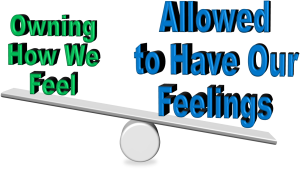 As a society, I think we have gone overboard on the “let them have their feelings” thing. Please allow me to qualify that position.
As a society, I think we have gone overboard on the “let them have their feelings” thing. Please allow me to qualify that position.
First, I believe we are feeling creatures. And, we are absolutely entitled to our emotions. What I want to explore, is how we process events and feelings and how that affects civil discourse.
 In recent decades, psychology and therapy have made great strides in qualifying the importance of acknowledging feelings and working with them. In order to help a person in emotional pain, first empathy then exploration. Sometimes just being empathetic will suffice. In order to help ourselves, first identify how we feel, then explore to see if the feeling has a valid, or false, underpinning. I am a strong proponent of these things and the cognitive therapy model. More on that in a future post.
In recent decades, psychology and therapy have made great strides in qualifying the importance of acknowledging feelings and working with them. In order to help a person in emotional pain, first empathy then exploration. Sometimes just being empathetic will suffice. In order to help ourselves, first identify how we feel, then explore to see if the feeling has a valid, or false, underpinning. I am a strong proponent of these things and the cognitive therapy model. More on that in a future post.
 Also in recent decades, TV & radio, talk shows, movies, court cases and such, have increased public awareness to the first half of this dynamic – the importance of acknowledging feelings. By itself – not a bad thing. Unfortunately, in my opinion, the other half of the equation – personally owning how we feel and then act – has not been given the same attention, emphasis or depth of consideration.
Also in recent decades, TV & radio, talk shows, movies, court cases and such, have increased public awareness to the first half of this dynamic – the importance of acknowledging feelings. By itself – not a bad thing. Unfortunately, in my opinion, the other half of the equation – personally owning how we feel and then act – has not been given the same attention, emphasis or depth of consideration. Admittedly, it is the more complex half. I think the result of this disproportionate emphasis, is lots of people acting in highly-charged ways and justifying their behavior as a natural, even unavoidable, byproduct of their (hurt) feelings.
Admittedly, it is the more complex half. I think the result of this disproportionate emphasis, is lots of people acting in highly-charged ways and justifying their behavior as a natural, even unavoidable, byproduct of their (hurt) feelings.
I believe that this imbalance is undermining civil discourse (and relationships).
So, I would like to continue to expand using two cornerstone concepts:
- Our feelings flow from our perception of events.
- We have the ability to pause when an event (or comment) occurs, before responding.
Let me work backwards with those concepts. First, in most cases, and there are exceptions, we have the ability to gather our thoughts about an event or comment and sculpt a considered response, instead of just automatically reacting. Yes, we have lower brain functions (reptilian brain) that instinctually drive immediate reactions to real, imminent danger. But we have higher brain functions that allow for reasoning before reacting. In my opinion, we do not consistently teach or enforce this notion. I think the imbalance mentioned above, and longer held (inaccurate) social assumptions, has a lot to do with it. Some suggest this pause could equate to suppressing our “true” emotions. I disagree. I do not suggest suppressing or stuffing down our emotions. I do suggest we can actively manage them.
That leads to the first cornerstone concept – our emotions come from, flow from, our thoughts. They are not automatic. There is a sequence:
- an event occurs
- we perceive the event (or not)
- we process the event (thinking)
- we then feel as a result of that internal processing
In step 1, the event is a thing unto itself. It could be something happening outside of us, like a person running by. Or it could be something inside us, like remembering the taste of a slice of fresh peach pie. In the first instance, if the person running by were not in our field of vision, we may never have perceived, or been aware of, that occurrence. If we are not aware of the runner (step 2), then steps 3 and 4 never occur. We don’t have a feeling about something completely outside our awareness. On the other hand, if we do come to awareness of the event, because we turned and saw them as they ran by, or someone tells us about the runner, we move to step 3.
 In step 3, we digest the information about the runner, and form an opinion about it. The opinion can range from a simple acknowledgement of “some people run”, to a critique or liking of their outfit, to disapproval because this is not a place where someone should be running, or some other conclusion. Our opinion is often, but not always, based on the context of the event, AND most certainly based on our past experiences which affect our opinions. Once we have formed our opinion, which is likely to be very rapidly, we move to step 4.
In step 3, we digest the information about the runner, and form an opinion about it. The opinion can range from a simple acknowledgement of “some people run”, to a critique or liking of their outfit, to disapproval because this is not a place where someone should be running, or some other conclusion. Our opinion is often, but not always, based on the context of the event, AND most certainly based on our past experiences which affect our opinions. Once we have formed our opinion, which is likely to be very rapidly, we move to step 4.
In step 4, we transition from our opinion to how we feel about it. There is an emotion, and possibly a physical sensation, associated with our distilled perception of the runner. If we liked the outfit, we have a particular feeling (I’ll let you label it for yourself). If we disapprove of their actions, then some form of negative feeling (mild or otherwise) is associated with that disapproval. Or if disinterested, our emotion might just be a very mild and very brief “hm.”
The time span from the beginning of step 1 through the end of step 4 may be infinitesimally small. But it is not instantaneous nor is our resultant feeling unavoidable and automatic. We have the ability, during step 3, to intervene, to elongate our evaluation and shape our opinion. You may have been exposed to this if you were taught “count to ten when you are angry” when you were young. In elongating our evaluation, maybe we realize we don’t have the full context of why they were running, or why in this place, or other factors. Perhaps there was a valid, urgent, matter to which they needed to attend. That context could make the difference between a comment of derision, and a sense of concern for their well being. We also have the opportunity, during this pause, to challenge our assumptions about the event or person, and shape our conclusion, and the resultant emotion and response.
In the case of recalling the piece of pie, or pretty much any memory, it is sort a combination of steps 1 and 2. Once there, we precede to steps 3 and 4 – we form an opinion about the memory, then a feeling ensues. We can shift our perspective of that memory in different ways. And, in so doing, affect the resultant emotion. We could gather a pleasant feeling because it was yummy. Or we feel sadness because the person that makes it is no longer with us. And we could do both. We can actively choose to spend time in one emotion more than the other.
We own how we feel
 A crucial point, in all this, is that we, each, personally own steps 3 & 4. We cannot blame another for how we feel. We form the opinion (not them) and that leads to the emotion. So the expression “he said X and made me angry” is a misplacement for the anger. He may have indeed said X (step 1, the event), and that can be labeled as the trigger. We were aware he said X (step 2), and that may lead (via steps 3 & 4) to us feeling angry. But we own that anger. We can pause at step 3 and decide it is less egregious than our “visceral” reaction suggests, and respond with less anger or no anger. Or, with consideration, spawn a line of inquiry to negotiate with the other instead of becoming embattled. Regardless, the event, and the other person, is separate from the feeling. The emotional response is up to us.
A crucial point, in all this, is that we, each, personally own steps 3 & 4. We cannot blame another for how we feel. We form the opinion (not them) and that leads to the emotion. So the expression “he said X and made me angry” is a misplacement for the anger. He may have indeed said X (step 1, the event), and that can be labeled as the trigger. We were aware he said X (step 2), and that may lead (via steps 3 & 4) to us feeling angry. But we own that anger. We can pause at step 3 and decide it is less egregious than our “visceral” reaction suggests, and respond with less anger or no anger. Or, with consideration, spawn a line of inquiry to negotiate with the other instead of becoming embattled. Regardless, the event, and the other person, is separate from the feeling. The emotional response is up to us.
That is how I see this folding into civil discourse – and more civil behavior. There seems to be far too much heated, reactionary behavior, in what could be civil discourse today. I choose not to elaborate, here and now, on the potential reasons why such unreasoned conflict is encouraged. That is for another post.
 So I circle back to conclusion on the premise and title of this post. Imagine two or more parties, engaged in a difficult conversation, with deeply held opposing points of view, conducting themselves in this way – responding to each other rather being entrenched and reactionary. I firmly believe, that if we learn, practice and encourage this discipline, we can improve our dialogs, advance our points and causes (and society) more effectively, more rapidly and more often.
So I circle back to conclusion on the premise and title of this post. Imagine two or more parties, engaged in a difficult conversation, with deeply held opposing points of view, conducting themselves in this way – responding to each other rather being entrenched and reactionary. I firmly believe, that if we learn, practice and encourage this discipline, we can improve our dialogs, advance our points and causes (and society) more effectively, more rapidly and more often.